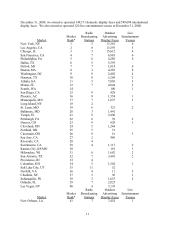iHeartMedia 2000 Annual Report Download - page 20
Download and view the complete annual report
Please find page 20 of the 2000 iHeartMedia annual report below. You can navigate through the pages in the report by either clicking on the pages listed below, or by using the keyword search tool below to find specific information within the annual report.20
market, and from having an attributable interest in a radio or television station and a daily newspaper
located in the same market.
Prior to August 1999, FCC rules also generally prohibited common ownership of a television
station and one or more radio stations in the same market, although the FCC in many cases allowed such
combinations under waivers of the rule. In August 1999, however, the FCC comprehensively revised its
radio/television cross-ownership rule. The revised rule permits the common ownership of one television
and up to seven same-market radio stations, or up to two television and six same-market radio stations, if
the market will have at least twenty separately owned broadcast, newspaper and cable “voices” after the
combination. Common ownership of up to two television and four radio stations is permissible when ten
“voices” will remain, and common ownership of up to two television stations and one radio station is
permissible in all markets regardless of voice count. The radio/television limits, moreover, are subject to
the compliance of the television and radio components of the combination with the television duopoly
rule and the local radio ownership limits, respectively. Waivers of the radio/television cross-ownership
rule are available only where the station being acquired is “failed” (i.e., off the air for at least four months
or involved in court-supervised involuntary bankruptcy or insolvency proceedings). A buyer seeking
such a waiver must also demonstrate, in most cases, that it is the only buyer ready, willing, and able to
operate the station, and that sale to an out-of-market buyer would result in an artificially depressed price.
There are 14 markets where we own both radio and television stations. In the majority of these
markets, the number of radio stations we own complies with the limit imposed by the revised rule. In
those markets where our number of radio stations exceeds the limit under the revised rule, we are
nonetheless authorized to retain our present television/radio combinations at least until 2004, when the
FCC is scheduled to undertake a comprehensive review and re-evaluation of its broadcast ownership
rules. As with grandfathered television LMAs, we may seek permanent authorization for our non-
compliant radio/television combinations by demonstrating to the FCC, among other things, the public
interest benefits the combinations have produced and the extent to which the combinations have enabled
the television stations involved to convert to digital operation.
Expansion of our broadcast operations in particular areas and nationwide will continue to be
subject to the FCC’ s ownership rules and any further changes the FCC or Congress may adopt.
Significantly, the 1996 Act requires the FCC to review its remaining ownership rules biennially as part of
its regulatory reform obligations to determine whether its various rules are still necessary. The first such
biennial review concluded on June 20, 2000, with the FCC’ s issuance of a report retaining the 35%
national television reach limitation, the cable system/television station cross-ownership rule, and the
limits on the number of radio stations a company may own in a given market. In its report, however, the
FCC stated its intention to commence separate proceedings requesting specific comment on
























